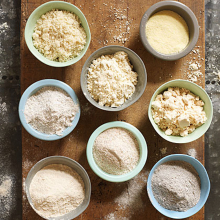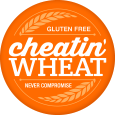- Oct 07, 2016
You may be asking yourself, "What is gluten free flour made of?" And the answer is, "It depends on which one you buy." There are now more gluten free all-purpose flour blends than ever. In addition, many single ingredient gluten free flours/starches such as teff, tapioca, garbanzo, coconut, and banana have emerged in the market. In some ways, it can all be too much. How do you choose which is the best gluten free flour? And more importantly, how do you use them in your recipes?
Gluten Free Flour Blend or Gluten Free Ingredient Flour
 "Flours" are a powder which is made from grinding up cereal grains, other seeds or roots. It does not just refer to wheat, but rather the milling and final particle size. You can make flour out of most anything which is why there is such a wide variety of gluten free ingredient options. I firmly believe a gluten free flour blend is better for gluten free baking 99.9% of the time. Trying to replicate all the roles traditional flour plays in baking is complex. You have to think about things like flavor, texture, hydration, the gelatinization point of the starches, etc. Therefore, we prefer to use a combination of different gluten free flours and gluten free starches to create flavor, texture and balance.
"Flours" are a powder which is made from grinding up cereal grains, other seeds or roots. It does not just refer to wheat, but rather the milling and final particle size. You can make flour out of most anything which is why there is such a wide variety of gluten free ingredient options. I firmly believe a gluten free flour blend is better for gluten free baking 99.9% of the time. Trying to replicate all the roles traditional flour plays in baking is complex. You have to think about things like flavor, texture, hydration, the gelatinization point of the starches, etc. Therefore, we prefer to use a combination of different gluten free flours and gluten free starches to create flavor, texture and balance.
Other Allergens Exist in All-Purpose Gluten Free Flour Blends
Once I have sold you on the idea of blend, now you have to consider the ingredients. Being a part of the allergen community has taught me that rarely do our customers have just one food they try to avoid. Maybe you have to avoid corn or soy or potato in addition to gluten. If so, you may have to kick some brands to the curb because of other allergens you are avoiding.
Not All Gluten Free Flour Blends are Created Equal
If they were, they would be easy to use, blend seemlessly into your old recipes and create gluten free foods that taste just like their traditional, wheat-based counterparts. So what is the difference? First off, a great all purpose gluten free flour blend should not contain ingredients such as salt, baking powder, baking soda, guar gum or xanthan gum. Think about it! You want different amounts of all of those things if you are making gluten free cookies versus gluten free pasta. And since you have no way of knowing the exact amounts of those things in the blend, you do not know how to adapt your recipe. Now you are locked into using their gluten free recipes and gluten free foods list. Bah!
Measures Cup for Cup
Every gluten free flour company out there, including us, makes this claim. Heck, this is actually a brand name which underscores its seeming importance to successful gluten free recipe conversions. And while it is nice to know the measurements should be similar, there will always be some adjustments, especially if you are a less-than-precise baker to begin with.
Tips to Using Gluten Free Flour Blends
1. Add xanthan gum when baking otherwise your finished baked goods will likely end up tasting like a pile of crumbs! Now, a little goes a long way and if you use too much xanthan gum in a recipe you may notice a heavy, gummy or even slimy texture - so measure carefully. We recommend starting with 1/2 tsp of xanthan per cup of gluten free flour in gluten free cookies and 1 tsp of xanthan per cup of gluten free flour in gluten free cakes and gluten free breads. It is also important to note that you do not need to use xanthan gum in most savory applications such as making a roux, dredging fish fillets or creating a batter for gluten free fried foods.
2. Convert the gluten free flour portion of your recipe to weight instead of measuring by cups. For example, did you know a cup of gluten free flour can weigh anywhere from 3-6 oz depending on the brand and who is doing the scooping? We say a cup of Cheatin' Wheat flour weighs 4.6 oz or 130 grams. But this weight does not necessarily apply to other blends and it is important to note that you may experience a slightly different measurement. The best way to determine the amount you use in your recipes is to grab a scale and see what a cup of flour weighs when you scoop it. Everyone "scoops" a little differently and your recipes work with you as the cook!
3. Contact Cheatin' Wheat. We are here to help and will always provide recipe support, answer baking questions and do our best to make your gluten free foods the best they can be!





 Find our products
Find our products FAQs
FAQs Testimonials
Testimonials R&D Projects
R&D Projects